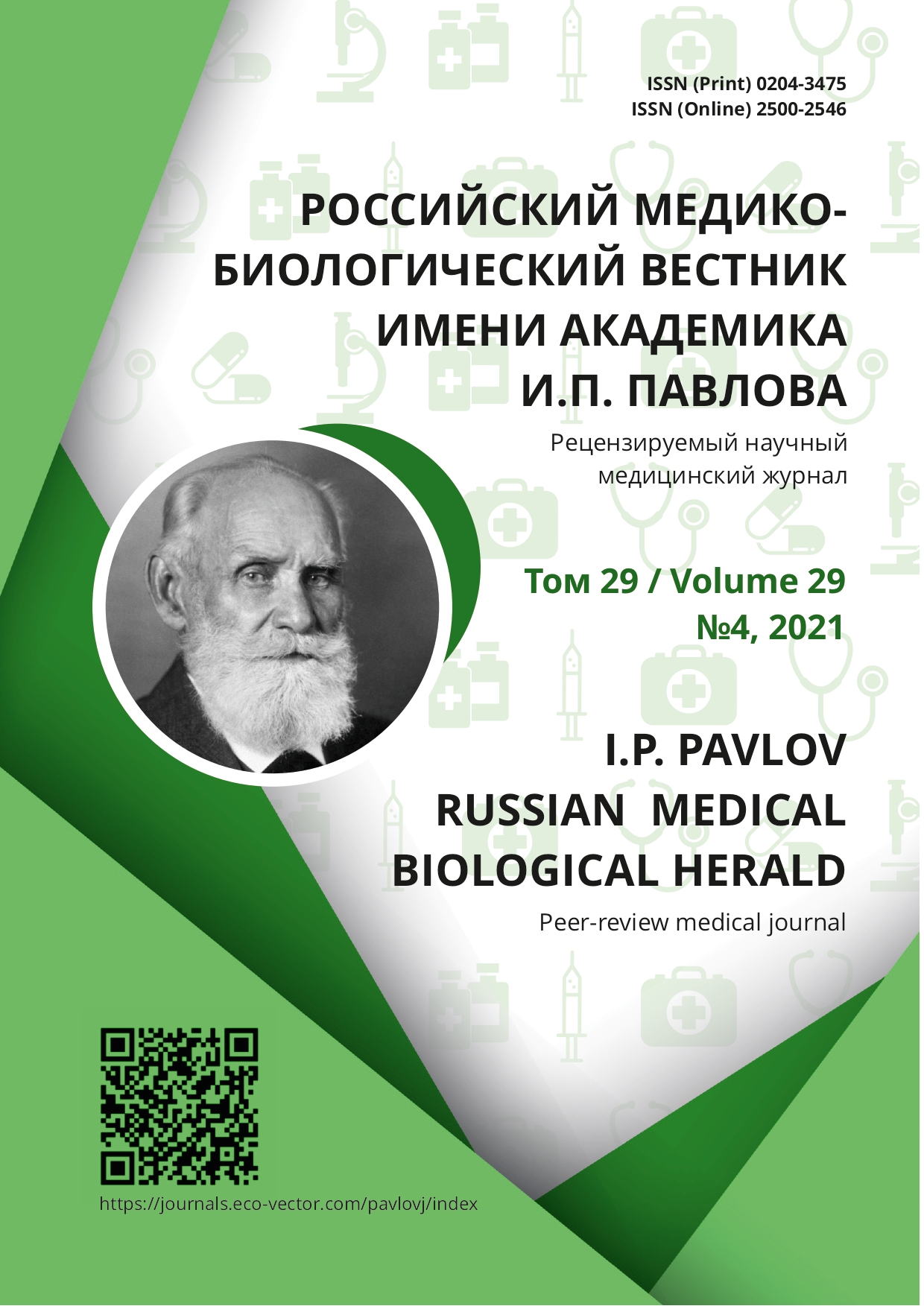Magnetic resonance imaging in the diagnosis for predictors of ventral hernia recurrence
- Authors: Fedoseev A.V.1, Shklyar V.S.1, Lebedev S.N.1, Inyutin A.S.1
-
Affiliations:
- Ryazan State Medical University
- Issue: Vol 29, No 4 (2021)
- Pages: 505-512
- Section: Original study
- Submitted: 14.10.2021
- Accepted: 24.11.2021
- Published: 15.12.2021
- URL: https://journals.eco-vector.com/pavlovj/article/view/83095
- DOI: https://doi.org/10.17816/PAVLOVJ83095
- ID: 83095
Cite item
Abstract
Introduction: The problem of surgical treatment of patients with ventral hernias remains actual over years. This is due to significant number of patients with this pathology as well as a steadily high percentage of recurrence of the disease after reconstructive operations (24%–44%).
Aim: To identify the interrelation between the constitutional peculiarities of patients and the condition of the anterior abdominal wall tissues as predictors of the formation and recurrence of ventral hernias, based on the results of magnetic-resonance study.
Materials and methods: To assess the connection between the body constitution, the age and the morphological structure of the anterior abdominal wall, we examined 71 patients who were referred for magnetic-resonance examination of the abdominal cavity. In the work, the age of the patients was defined (WHO classification (2015)), and the body mass index. To reveal the signs of undifferentiated connective tissue dysplasia (CTD), the chart by T. Milkovska–Dmitrova and A. Karkashev (1985) was used. For statistical processing of the data and construction of the graph, Statistica 13.3, SPSS 14.0 for Windows Evaluation Version, MS Excel 2016 statistic packages were used.
Results: Fatty degeneration of muscle tissue (DMT) prevails among elder individuals (rxy=-0.540; p< 0.05). Obesity is accompanied by diastasis of abdominal rectus muscles (rxy=0.806, p< 0.05) and fatty degeneration (rxy=0.568; p< 0.05). Connective tissue dysplasia is closely associated with the rectus muscle diastasis (rxy=0.948; tСт=3.834; p< 0.05) and distension of the umbilical ring (rxy=0.934; T-test=3.703, p< 0.05). Latent aponeurosis defects are also most characteristic of patients with connective tissue dysplasia; however, this dependence was not statistically confirmed in the studied cohort (rxy=0.258; T-test=0.734, p> 0.05).
Conclusion: Вefore planning surgical intervention for ventral hernia, we recommend MRI examination of the anterior abdominal wall tissues be performed in patients for determination of the volume of the intervention to prevent recurrence.
Keywords
Full Text
About the authors
Andrey V. Fedoseev
Ryazan State Medical University
Email: hirurgiarzn@gmail.com
ORCID iD: 0000-0002-6941-1997
SPIN-code: 6522-1989
Scopus Author ID: 7005122675
ResearcherId: S-8606-2016
MD, Dr. Sci. (Med.), Professor
Russian Federation, RyazanVyacheslav S. Shklyar
Ryazan State Medical University
Email: hirurgiarzn@gmail.com
ORCID iD: 0000-0002-7267-4085
SPIN-code: 9683-9598
Postgraduate student of the Department of General Surgery
Russian Federation, RyazanSergey N. Lebedev
Ryazan State Medical University
Email: dguba_dze@mail.ru
ORCID iD: 0000-0002-7139-7100
SPIN-code: 3482-3313
Scopus Author ID: 57209758284
ResearcherId: D-8177-2018
MD, Cand. Sci. (Med.)
Russian Federation, RyazanAlexander S. Inyutin
Ryazan State Medical University
Author for correspondence.
Email: aleksandr4007@rambler.ru
ORCID iD: 0000-0001-8812-3248
SPIN-code: 7643-9022
Scopus Author ID: 57195950651
ResearcherId: D-4482-2018
Cand. Sci. (Med.), Associate Professor
Russian Federation, RyazanReferences
- Seo GH, Choe EK, Park KJ, et al. Incidence of Clinically Relevant Incisional Hernia After Colon Cancer Surgery and Its Risk Factors: A Nationwide Claims Study. World Journal of Surgery. 2018;42(4):1192–9. doi: 10.1007/s00268-017-4256-4
- Fedoseev AV, Muraviev SJ, Budarev VN, et al. Some features of the white line of the abdomen, as the harbingers of post-operative hernia I.P. Pavlov Russian Medical Biological Herald. 2016;(1):109–15. (In Russ).
- Poruk KE, Farrow N, Azar F, et al. Effect of hernia size on operative repair and post-operative outcomes after open ventral hernia repair. Hernia. 2016;20(6):805–10. doi: 10.1007/s10029-016-1542-2
- Parshikov VV, Fedaev AA. Abdominal Wall Prosthetic Repair in Ventral and Incisional Hernia Treatment: Classification, Terminology and Technical Aspects (Review). Modern Technologies in Medicine. 2015;7(2):138–52. (In Russ). doi: 10.17691/stm2015.7.2.19
- Morris-Stiff GJ, Hughes LE. The outcomes of nonabsorbable mesh placed within the abdominal cavity: literature review and clinical experience. Journal of the American College of Surgeons. 1998;186(3):352–67. doi: 10.1016/s1072-7515(98)00002-7
- Samartsev VA, Gavrilov VA, Kuchumov AG. Differentiated application of single-row suture for prevention of surgical infection in abdominal surgery. Novosti Khirurgii. 2013;21(6):38–46. (In Russ).
- Shestak KC, Edington HJ, Johnson RR. The separation of anatomic components technique for the reconstruction of massive midline abdominal wall defects: anatomy, surgical technique, applications and limitations revisited. Plastic and Reconstructive Surgery. 2000;105(2):731–8. doi: 10.1097/00006534-200002000-00041
- Christy MR, Apostolides J, Rodriguez ED, et al. The Component Separation Index: A Standardized Biometric Identity in Abdominal Wall Reconstruction. Eplasty. 2012;12:e17.
- Sukovatykh BS, Valujskaya NM, Pravednikova NV, et al. Prophylactics and treatment of postoperative hernias of the lateral abdominal walls using polypropylene endoprothesis. Vestnik khirurgii imeni I.I. Grekova. 2011;(3):53–7. (In Russ).
- Tashkinov NV, Kogut BM, Boyarintsev NI, et al. Prophylactic prosthetic mash placement for prevention of incisional ventral hernias following midline laparotomy. Far East Medical Journal. 2014;(4):117–22. (In Russ).
- Lebedev SN, Fedoseev AV, Inyutin AS, et al. Preventive surgical mash augmentation in middle laparotomy. Science of the young (Eruditio Juvenium). 2018;6(2):211–17. doi: 10.23888/HMJ201862211-217
Supplementary files













